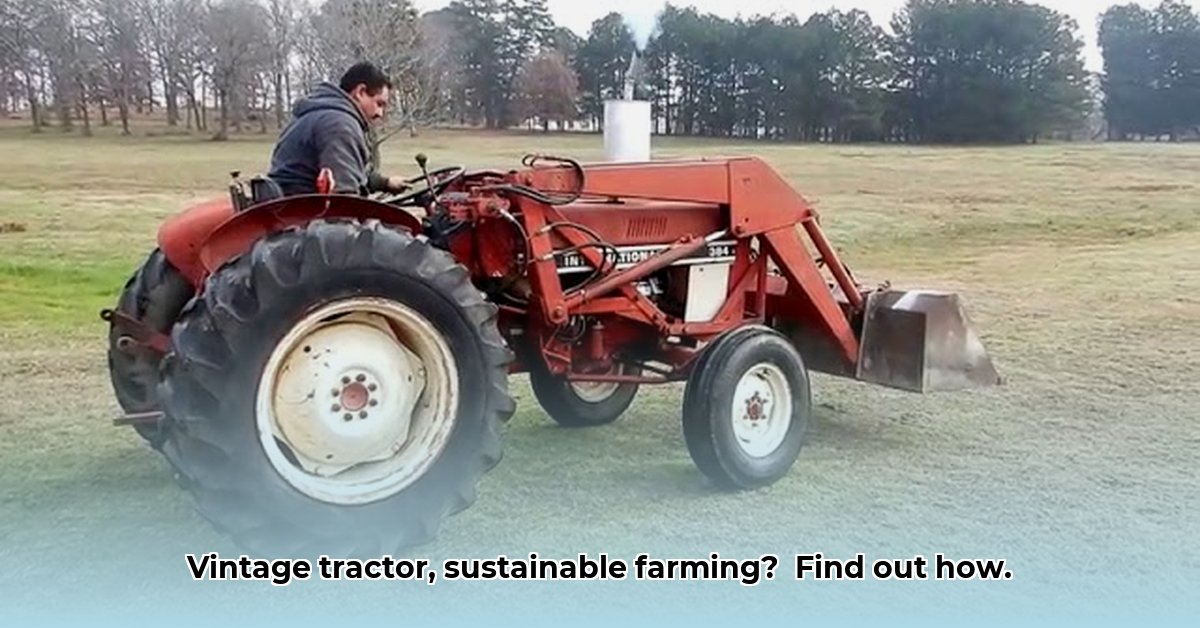
384 International Tractor: A Vintage Solution for Sustainable Farming?
The International Harvester 384, a robust workhorse from the late 1970s and early 1980s, is experiencing a resurgence, not for nostalgic reasons alone, but for its surprising potential in sustainable agriculture. This article investigates its suitability for modern, environmentally conscious farming practices. We'll examine technical specifications, repair accessibility, fuel efficiency, and the need for further research to fully assess its sustainability. For more on vintage tractors, check out this resource on vintage tractor restorations.
Technical Specifications and Design: A Closer Look
The 384 boasts a simple, robust design. Its 36-horsepower (hp) engine (a 4-cylinder, naturally aspirated engine), while less powerful than modern counterparts, proves efficient for various tasks on smaller farms. The key advantage lies in its straightforward mechanics and ease of repair. This simplicity reduces maintenance costs and downtime, vital for budget-conscious farmers. Parts are often easier to source and replace, reducing reliance on specialized and potentially distant repair services.
The 12-gallon fuel tank, although seeming small by modern standards, points to the potential for significant fuel savings and reduced emissions compared to larger, more powerful tractors. This potential for reduced environmental impact is a substantial draw for environmentally conscious farmers.
| Specification | Details |
|---|---|
| Engine | 4-cylinder, naturally aspirated |
| Horsepower | 36 hp |
| Transmission | Manual, typically 8 forward gears |
| Fuel Tank Capacity | 12 gallons |
| Weight | Approximately 4,000 lbs |
| Notable Features | Simplicity, ease of maintenance, robust design |
The 384 and Sustainable Agriculture: A Perfect Match?
The 384's appeal for sustainable agriculture stems from its practicality and resilience. Its uncomplicated design translates to exceptional durability. This makes it particularly suitable for smaller farms or those in regions with limited access to specialized repair services. The potential for reduced fuel consumption is another crucial factor. While precise data requires further analysis, the smaller engine and fuel tank suggest significantly lower greenhouse gas emissions compared to most modern tractors. This aligns perfectly with the goals of sustainable and environmentally friendly farming practices.
Isn't it remarkable how a seemingly simple design translates into such significant long-term environmental benefits?
Comparative Analysis: Filling the Knowledge Gaps
To definitively assess the 384's role in sustainable agriculture, a thorough comparison with modern tractors is crucial. This requires gathering comprehensive data on fuel efficiency (liters/hectare), lifecycle costs (initial purchase, maintenance, disposal), and embodied carbon (emissions from manufacture and use). Only with this data can we make a truly informed and objective comparison.
Currently, we have indications of potential benefits, but definitive conclusions require rigorous scientific investigation. This research is essential to comprehensively evaluate its long-term environmental impact.
Actionable Insights: What Can We Do Now?
To harness the 384's full potential, collaboration is key. Different stakeholders have vital roles to play:
1. Small-Scale Farmers:
a. Explore available 384s via local listings and auctions. b. Carefully assess long-term fuel, maintenance, and repair costs. c. Build a community to share repair knowledge and resources.
2. Agricultural Researchers:
a. Conduct comparative studies of fuel efficiency, emissions, and performance. b. Perform Lifecycle Analyses (LCA) to determine the total environmental impact. c. Explore the 384's use within agroecological farming systems.
3. Government Agencies & Policy Makers:
a. Develop policies to incentivize vintage tractor use in sustainable farming. b. Fund research to address data gaps. c. Promote training programs focused on tractor repair and maintenance.
4. Vintage Tractor Enthusiasts & Collectors:
a. Preserve operational and maintenance histories of these tractors. b. Offer educational demonstrations showcasing their use in sustainable farming.
The Path Forward: A Call to Action
The International Harvester 384 presents a promising pathway toward sustainable agriculture, but further research remains essential to confirm its benefits fully. This requires a collaborative effort—researchers, farmers, policymakers, and enthusiasts—working together to gather the necessary data and fully analyze its potential environmental impact. Ultimately, this collaborative investigation will help determine the 384's place in a more sustainable and resilient agricultural future.
How to Compare Fuel Efficiency of Vintage IH 384 Tractors to Modern Alternatives
Directly comparing the fuel efficiency of a vintage IH 384 to modern tractors demands a nuanced approach moving beyond simple "gallons per hour" figures. A more accurate comparison should focus on fuel consumed per unit of work accomplished. Factors such as soil type and terrain significantly influence fuel consumption. Additionally, the entire lifecycle, including embodied carbon, must be considered. Only through rigorous testing can we truly evaluate the long-term sustainability of this vintage tractor.